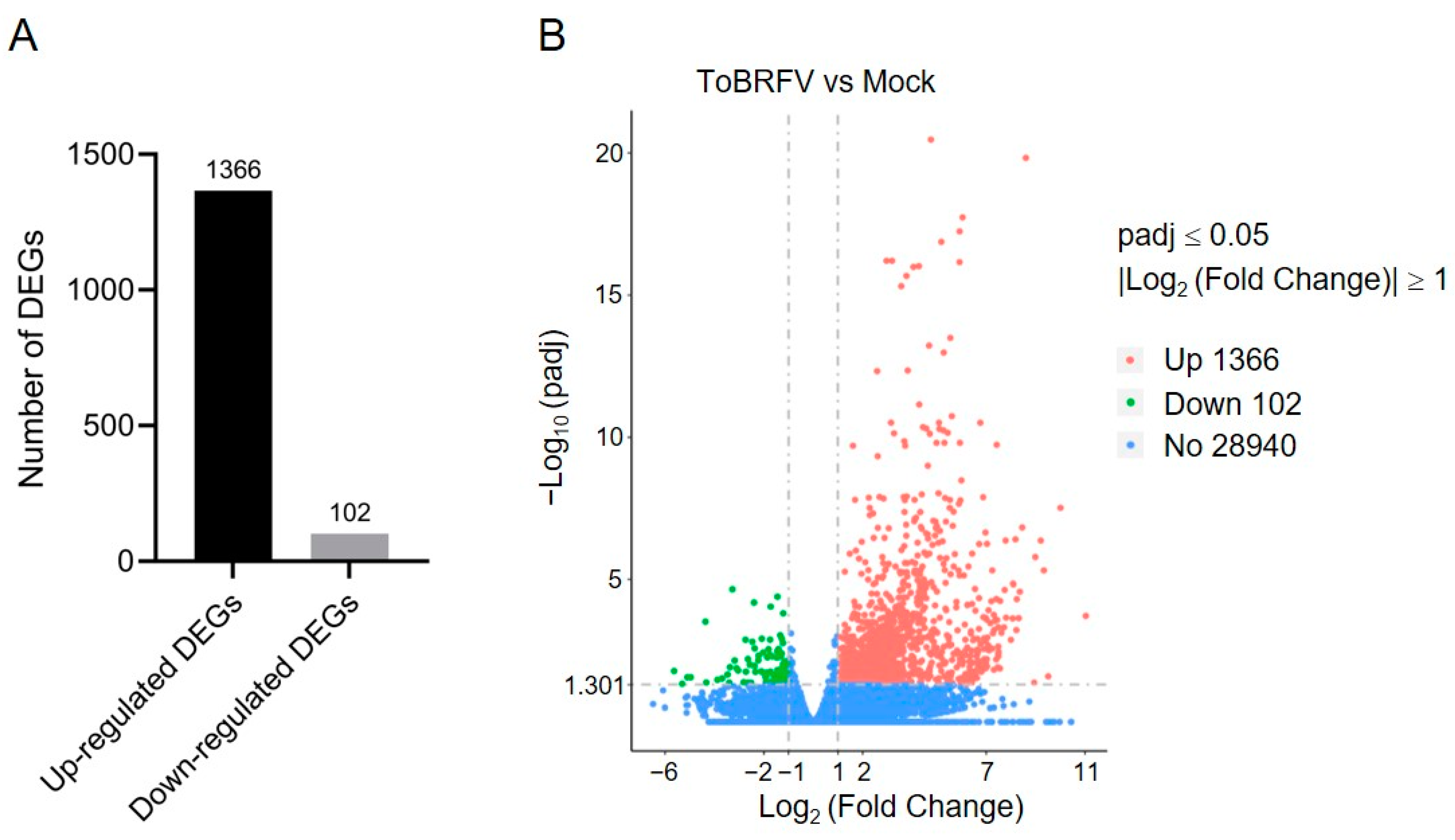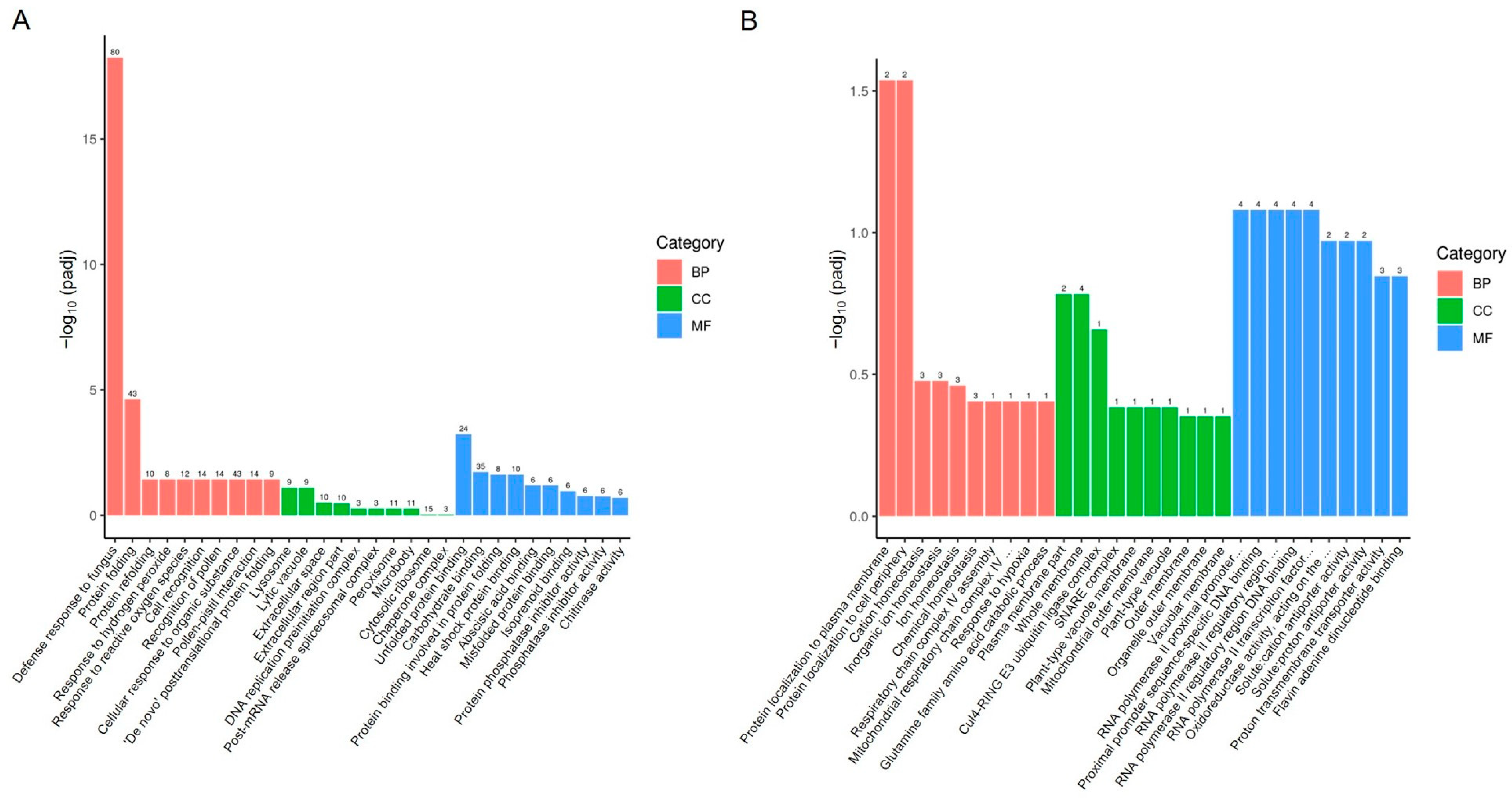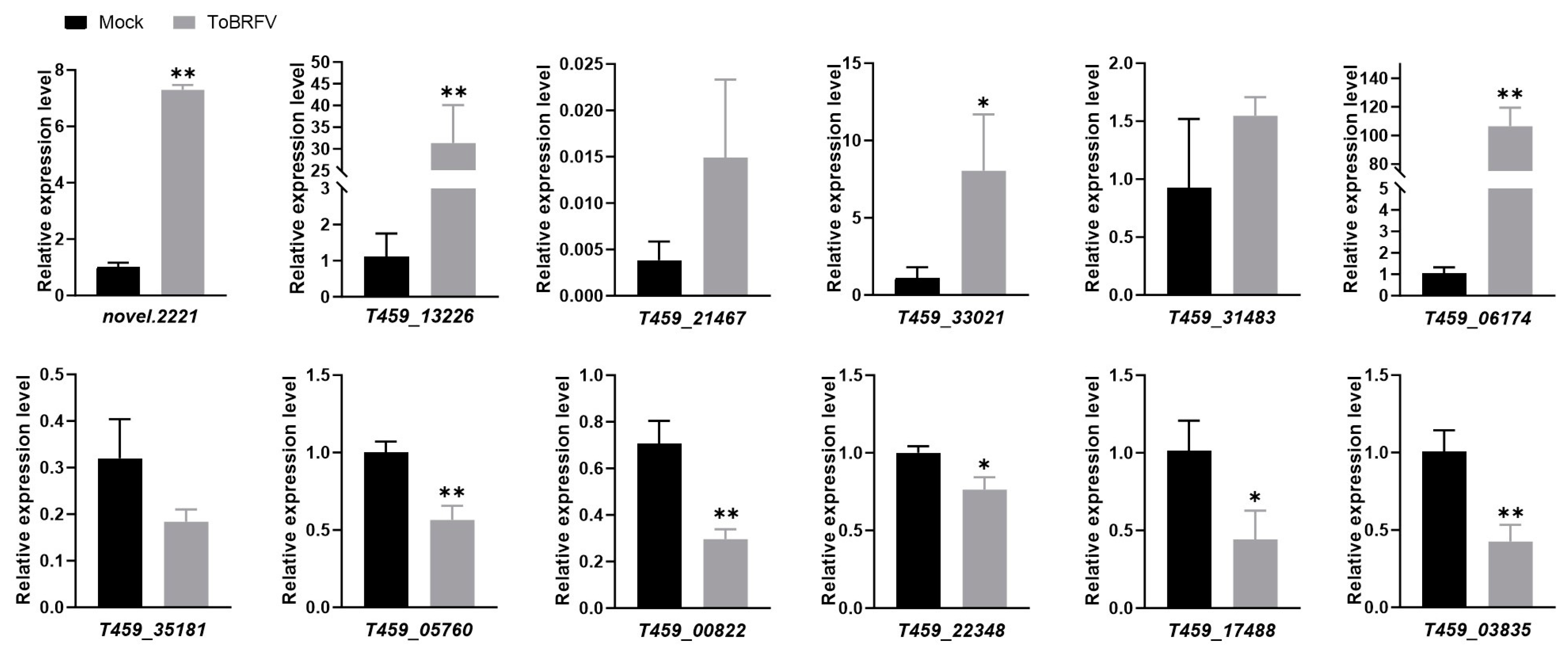Transcriptome Analysis of Pepper Leaves in Response to Tomato Brown Rugose Fruit Virus Infection
Abstract
1. Introduction
2. Results
2.1. Preparation of Transcriptome Samples from ToBRFV-Infected Pepper Leaves
2.2. Sequencing and De Novo Assembly of Transcriptome
2.3. Identification of DEGs in Pepper Leaves Responding to ToBRFV
2.4. GO and KEGG Enrichment Analysis of DEGs
2.5. Validation of DEGs by Quantitative PCR
3. Discussion
4. Materials and Methods
4.1. Plant Cultivation and ToBRFV Inoculation
4.2. Transcriptome Sequencing Library Construction, Quality Control, and Sequencing
4.3. Data Quality Control
4.4. Alignment of Sequences to the Reference Genome
4.5. Gene Expression Quantification and Differential Expression Analysis
4.6. DEGs GO and KEGG Enrichment Analysis
4.7. Real-Time Quantitative PCR (RT-qPCR)
5. Conclusions
Supplementary Materials
Author Contributions
Funding
Data Availability Statement
Acknowledgments
Conflicts of Interest
References
- Ibiza, V.P.; Blanca, J.; Cañizares, J.; Nuez, F. Taxonomy and genetic diversity of domesticated Capsicum species in the Andean region. Genet. Resour. Crop Evol. 2012, 59, 1077–1088. [Google Scholar] [CrossRef]
- Kenyon, L.; Kumar, S.; Tsai, W.S.; Hughes, J.d. Virus diseases of peppers (Capsicum spp.) and their control. Adv. Virus Res. 2014, 90, 297–354. [Google Scholar]
- Sam-On, M.F.S.; Mustafa, S.; Yusof, M.T.; Hashim, A.M.; Aizuddin, K.N.A.K. Exploring the global trends of Bacillus, Trichoderma and entomopathogenic fungi for pathogen and pest control in chili cultivation. Saudi J. Biol. Sci. 2024, 31, 104046. [Google Scholar] [CrossRef] [PubMed]
- Jo, Y.; Choi, H.; Lee, J.H.; Moh, S.H.; Cho, W.K. Viromes of 15 pepper (Capsicum annuum L.) cultivars. Int. J. Mol. Sci. 2022, 23, 10507. [Google Scholar] [CrossRef] [PubMed]
- Zhang, Z.; Chang, X.; Luo, S.; Wang, Y.; Xuan, S.; Zhao, J.; Shen, S.; Ma, W.; Chen, X. Transcriptome analysis of two pepper genotypes infected with pepper mild mottle virus. Front. Genet. 2023, 14, 1164730. [Google Scholar] [CrossRef]
- Moury, B.; Verdin, E. Viruses of pepper crops in the Mediterranean basin: A remarkable stasis. Adv. Virus Res. 2012, 84, 127–162. [Google Scholar]
- Li, Y.; Tan, G.; Xiao, L.; Zhou, W.; Lan, P.; Chen, X.; Liu, Y.; Li, R.; Li, F. A multiyear survey and identification of pepper-and tomato-infecting viruses in Yunnan province, China. Front. Microbiol. 2021, 12, 623875. [Google Scholar] [CrossRef]
- Salem, N.; Mansour, A.; Ciuffo, M.; Falk, B.W.; Turina, M. A new tobamovirus infecting tomato crops in Jordan. Arch. Virol. 2016, 161, 503–506. [Google Scholar] [CrossRef]
- Luria, N.; Smith, E.; Reingold, V.; Bekelman, I.; Lapidot, M.; Levin, I.; Elad, N.; Tam, Y.; Sela, N.; Abu-Ras, A.; et al. A new Israeli Tobamovirus isolate infects tomato plants harboring Tm-22 resistance genes. PLoS ONE 2017, 12, e0170429. [Google Scholar] [CrossRef]
- Zhang, S.; Griffiths, J.S.; Marchand, G.; Bernards, M.A.; Wang, A. Tomato brown rugose fruit virus: An emerging and rapidly spreading plant RNA virus that threatens tomato production worldwide. Mol. Plant Pathol. 2022, 23, 1262–1277. [Google Scholar] [CrossRef]
- Salem, N.M.; Jewehan, A.; Aranda, M.A.; Fox, A. Tomato brown rugose fruit virus pandemic. Annu. Rev. Phytopathol. 2023, 61, 137–164. [Google Scholar] [CrossRef] [PubMed]
- Davino, S.; Caruso, A.G.; Bertacca, S.; Barone, S.; Panno, S. Tomato brown rugose fruit virus: Seed transmission rate and efficacy of different seed disinfection treatments. Plants 2020, 9, 1615. [Google Scholar] [CrossRef] [PubMed]
- Salem, N.M.; Sulaiman, A.; Samarah, N.; Turina, M.; Vallino, M. Localization and mechanical transmission of tomato brown rugose fruit virus in tomato seeds. Plant Dis. 2022, 106, 275–281. [Google Scholar] [CrossRef]
- Tomita, R.; Murai, J.; Miura, Y.; Ishihara, H.; Liu, S.; Kubotera, Y.; Honda, A.; Hatta, R.; Kuroda, T.; Hamada, H.; et al. Fine mapping and DNA fiber FISH analysis locates the tobamovirus resistance gene L3 of Capsicum chinense in a 400-kb region of R-like genes cluster embedded in highly repetitive sequences. Theor. Appl. Genet. 2008, 117, 1107–1118. [Google Scholar] [CrossRef] [PubMed]
- Tomita, R.; Sekine, K.T.; Mizumoto, H.; Sakamoto, M.; Murai, J.; Kiba, A.; Hikichi, Y.; Suzuki, K.; Kobayashi, K. Genetic basis for the hierarchical interaction between Tobamovirus spp. and L resistance gene alleles from different pepper species. Mol. Plant-Microbe Interact. 2011, 24, 108–117. [Google Scholar] [CrossRef]
- Fidan, H.; Sarikaya, P.; Yildiz, K.; Topkaya, B.; Erkis, G.; Calis, O. Robust molecular detection of the new tomato brown rugose fruit virus in infected tomato and pepper plants from turkey. J. Integr. Agric. 2021, 20, 2170–2179. [Google Scholar] [CrossRef]
- Jiao, Y.; An, M.; Li, X.; Yu, M.; Zhao, X.; Xia, Z.; Wu, Y. Transcriptomic and functional analyses reveal an antiviral role of autophagy during pepper mild mottle virus infection. BMC Plant Biol. 2020, 20, 495. [Google Scholar] [CrossRef]
- Kalapos, B.; Juhasz, C.; Balogh, E.; Kocsy, G.; Tóbias, I.; Gullner, G. Transcriptome profiling of pepper leaves by RNA-Seq during an incompatible and a compatible pepper-tobamovirus interaction. Sci. Rep. 2021, 11, 20680. [Google Scholar] [CrossRef]
- Widana Gamage, S.M.; McGrath, D.J.; Persley, D.M.; Dietzgen, R.G. Transcriptome analysis of capsicum chlorosis virus-induced hypersensitive resistance response in Bell capsicum. PLoS ONE 2016, 11, e0159085. [Google Scholar] [CrossRef]
- Zhu, C.; Li, X.; Zheng, J. Transcriptome profiling using Illumina-and SMRT-based RNA-seq of hot pepper for in-depth understanding of genes involved in CMV infection. Gene 2018, 666, 123–133. [Google Scholar] [CrossRef]
- Wang, D.; Chen, M.; Peng, J.; Zheng, H.; Lu, Y.; Wu, G.; Wu, J.; Li, J.; Chen, J.; Yan, F.; et al. Transcriptome analysis of tomato leaves reveals candidate genes responsive to tomato brown rugose fruit virus infection. Int. J. Mol. Sci. 2024, 25, 4012. [Google Scholar] [CrossRef]
- Meng, X.Z.; Zhang, S.Q. MAPK cascades in plant disease resistance signaling. Annu. Rev. Phytopathol. 2013, 51, 245–266. [Google Scholar] [CrossRef] [PubMed]
- Jagodzik, P.; Tajdel-Zielinska, M.; Ciesla, A.; Marczak, M.; Ludwikow, A. Mitogen-activated protein kinase cascades in plant hormone signaling. Front. Plant Sci. 2018, 9, 1387. [Google Scholar] [CrossRef] [PubMed]
- Yang, M.; Ismayil, A.; Liu, Y. Autophagy in plant-virus interactions. Annu. Rev. Virol. 2020, 7, 403–419. [Google Scholar] [CrossRef]
- Staiger, D.; Brown, J.W. Alternative splicing at the intersection of biological timing, development, and stress responses. Plant Cell 2013, 25, 3640–3656. [Google Scholar] [CrossRef] [PubMed]
- Mandadi, K.K.; Scholthof, K.B. Genome-wide analysis of alternative splicing landscapes modulated during plant-virus interactions in Brachypodium distachyon. Plant Cell 2015, 27, 71–85. [Google Scholar] [CrossRef]
- Glushkevich, A.; Spechenkova, N.; Fesenko, I.; Knyazev, A.; Samarskaya, V.; Kalinina, N.O.; Taliansky, M.; Love, A.J. Transcriptomic reprogramming, alternative splicing and RNA methylation in potato (Solanum tuberosum L.) plants in response to potato virus Y infection. Plants 2022, 11, 635. [Google Scholar] [CrossRef]
- Herath, V.; Casteel, C.L.; Verchot, J. Comprehensive transcriptomic analysis reveals turnip mosaic virus infection and its aphid vector Myzus persicae cause large changes in gene regulatory networks and co-transcription of alternative spliced mRNAs in Arabidopsis thaliana. BMC Plant Biol. 2025, 25, 128. [Google Scholar] [CrossRef]
- Li, S.; Guo, W.; Wang, C.; Tang, Y.; Li, L.; Zhang, H.; Li, Y.; Wei, Z.; Chen, J.; Sun, Z. Alternative splicing impacts the rice stripe virus response transcriptome. Virology 2023, 587, 109870. [Google Scholar] [CrossRef]
- Zheng, Y.; Wang, Y.; Ding, B.; Fei, Z. Comprehensive transcriptome analyses reveal that potato spindle tuber viroid triggers genome-wide changes in alternative splicing, inducible trans-acting activity of phased secondary small interfering RNAs, and immune responses. J. Virol. 2017, 91, e00247-17. [Google Scholar] [CrossRef]
- Livak, K.J.; Schmittgen, T.D. Analysis of relative gene expression data using real-time quantitative PCR and the 2−ΔΔCT method. Methods 2001, 25, 402–408. [Google Scholar] [CrossRef]





| Sample | Mock-1 | Mock-2 | Mock-3 | ToBRFV-1 | ToBRFV-2 | ToBRFV-3 |
|---|---|---|---|---|---|---|
| Raw_Read | 48,395,916 | 40,271,370 | 47,622,208 | 46,630,278 | 44,595,956 | 44,872,350 |
| Clean_reads | 47,391,258 | 39,288,882 | 46,576,848 | 45,595,038 | 43,575,074 | 43,617,228 |
| Effective (%) | 97.92 | 97.56 | 97.80 | 97.78 | 97.71 | 97.20 |
| Total_Map (%) | 42,306,124 (89.27) | 34,720,751 (88.37) | 41,700,214 (89.53) | 40,875,579 (89.65) | 38,642,689 (88.68) | 38,950,973 (89.30) |
| Unique_Map (%) | 40,382,064 (85.21) | 33,304,170 (84.77) | 39,960,963 (85.80) | 39,548,312 (86.74) | 36,923,883 (84.74) | 37,406,207 (85.76) |
| Q20 (%) | 98.3 | 97.26 | 97.45 | 97.65 | 97.34 | 97.53 |
| Q30 (%) | 95.34 | 92.88 | 93.25 | 93.71 | 93.04 | 93.35 |
| GC Contents (%) | 42.92 | 42.58 | 42.85 | 42.88 | 43.11 | 43.14 |
| Gene Name | Description | CK_1 | CK_2 | CK_3 | 13d_1 | 13d_2 | 13d_3 | log2 (Fold Change) | Regulation |
|---|---|---|---|---|---|---|---|---|---|
| novel.2221 | Receptor kinase-like protein | 0.0 | 0.0 | 0.0 | 71.0 | 14.3 | 170.5 | 9.0 | Up |
| T459_13226 | Defensin-like protein | 0.0 | 0.0 | 0.0 | 1.3 | 75.6 | 14.4 | 7.5 | Up |
| T459_21467 | Putative WRKY transcription factor | 7.9 | 14.3 | 6.7 | 4333.1 | 242.0 | 386.0 | 7.4 | Up |
| T459_33021 | Ethylene-responsive transcription factor | 0.0 | 0.0 | 0.0 | 32.9 | 4.1 | 1.0 | 6.2 | Up |
| T459_31483 | Very-long-chain aldehyde decarbonylase | 0.0 | 0.0 | 0.0 | 78.9 | 4.1 | 7.7 | 7.5 | Up |
| T459_06174 | Acidic endochitinase | 17.6 | 50.2 | 9.2 | 5989.3 | 579.9 | 1756.8 | 6.8 | Up |
| T459_35181 | Putative disease resistance protein | 25.6 | 28.7 | 24.4 | 3.9 | 0.0 | 4.8 | −3.2 | Down |
| T459_05760 | Calcium-binding protein | 181.5 | 149.5 | 126.9 | 56.6 | 66.4 | 90.0 | −1.1 | Down |
| T459_00822 | Transcription factor MYB111 | 330.4 | 222.2 | 239.5 | 18.4 | 17.4 | 96.8 | −2.6 | Down |
| T459_22348 | Transcription factor bHLH96 | 419.4 | 436.3 | 439.5 | 101.3 | 190.9 | 194.5 | −1.4 | Down |
| T459_17488 | Probable 2-oxoglutarate-dependent dioxygenase | 27.3 | 19.5 | 26.0 | 5.3 | 0.0 | 3.8 | −3.0 | Down |
| T459_03835 | Long-chain-alcohol oxidase | 133.0 | 114.7 | 95.0 | 10.5 | 30.6 | 23.0 | −2.4 | Down |
Disclaimer/Publisher’s Note: The statements, opinions and data contained in all publications are solely those of the individual author(s) and contributor(s) and not of MDPI and/or the editor(s). MDPI and/or the editor(s) disclaim responsibility for any injury to people or property resulting from any ideas, methods, instructions or products referred to in the content. |
© 2025 by the authors. Licensee MDPI, Basel, Switzerland. This article is an open access article distributed under the terms and conditions of the Creative Commons Attribution (CC BY) license (https://creativecommons.org/licenses/by/4.0/).
Share and Cite
Zhang, B.; Wang, D.; Chen, M.; Yang, J.; Li, J.; Chen, J.; Yan, F.; Rao, S. Transcriptome Analysis of Pepper Leaves in Response to Tomato Brown Rugose Fruit Virus Infection. Plants 2025, 14, 1280. https://doi.org/10.3390/plants14091280
Zhang B, Wang D, Chen M, Yang J, Li J, Chen J, Yan F, Rao S. Transcriptome Analysis of Pepper Leaves in Response to Tomato Brown Rugose Fruit Virus Infection. Plants. 2025; 14(9):1280. https://doi.org/10.3390/plants14091280
Chicago/Turabian StyleZhang, Boshen, Donghai Wang, Mangle Chen, Jiali Yang, Junmin Li, Jianping Chen, Fei Yan, and Shaofei Rao. 2025. "Transcriptome Analysis of Pepper Leaves in Response to Tomato Brown Rugose Fruit Virus Infection" Plants 14, no. 9: 1280. https://doi.org/10.3390/plants14091280
APA StyleZhang, B., Wang, D., Chen, M., Yang, J., Li, J., Chen, J., Yan, F., & Rao, S. (2025). Transcriptome Analysis of Pepper Leaves in Response to Tomato Brown Rugose Fruit Virus Infection. Plants, 14(9), 1280. https://doi.org/10.3390/plants14091280





